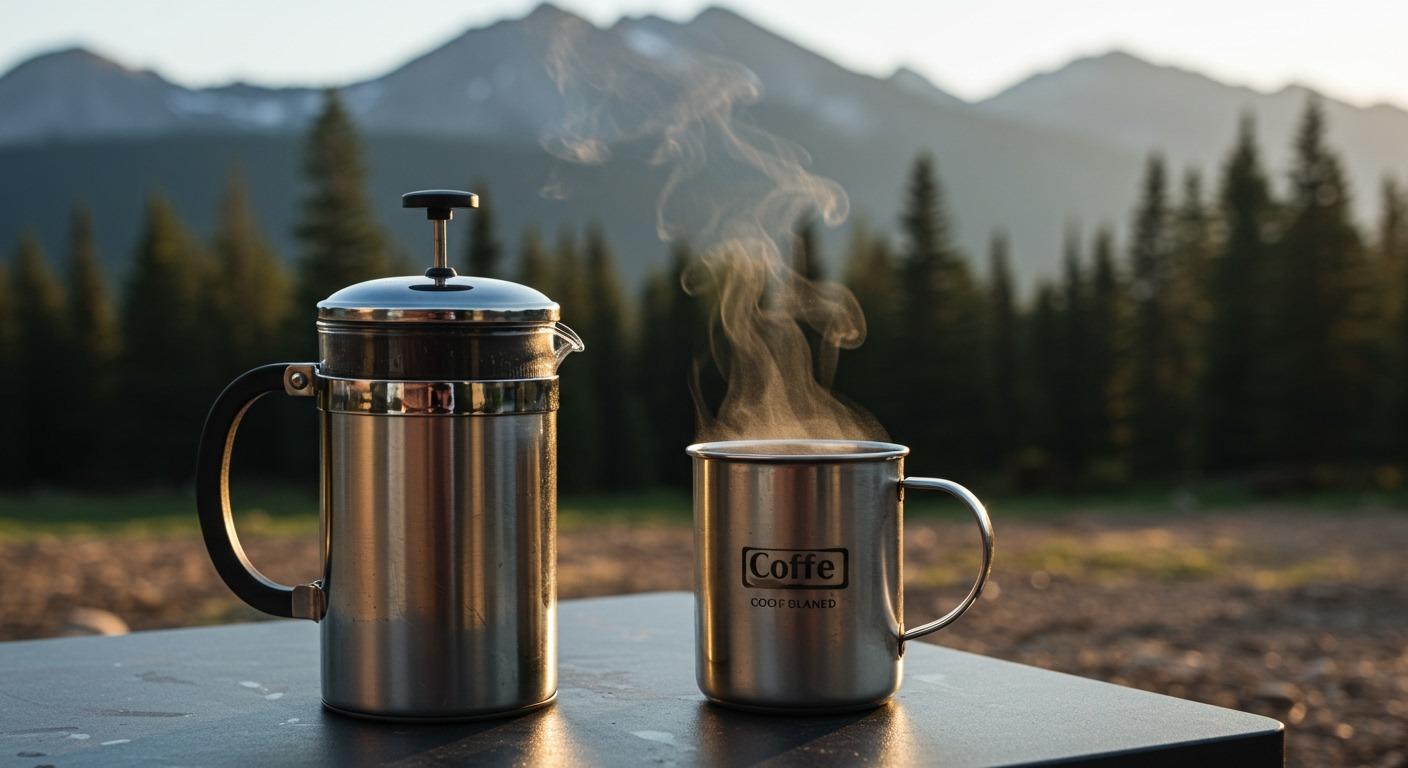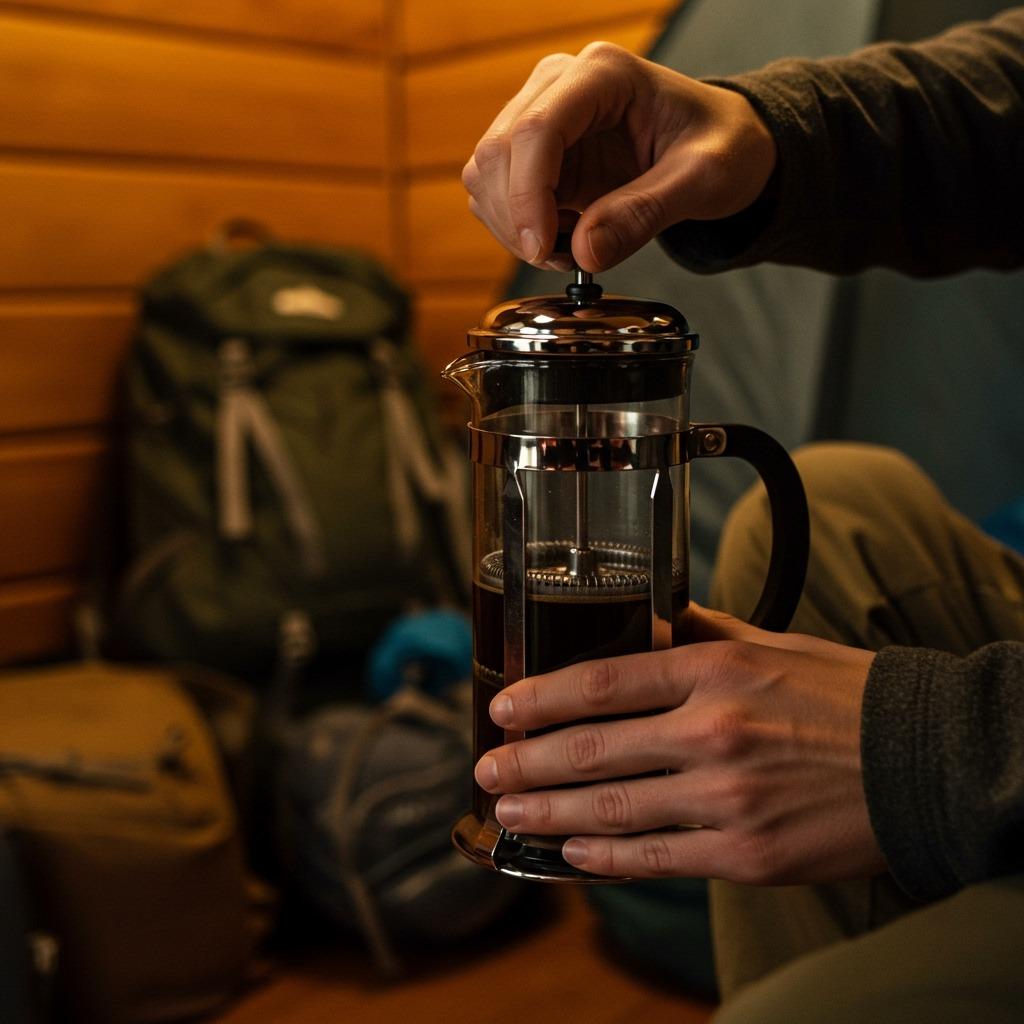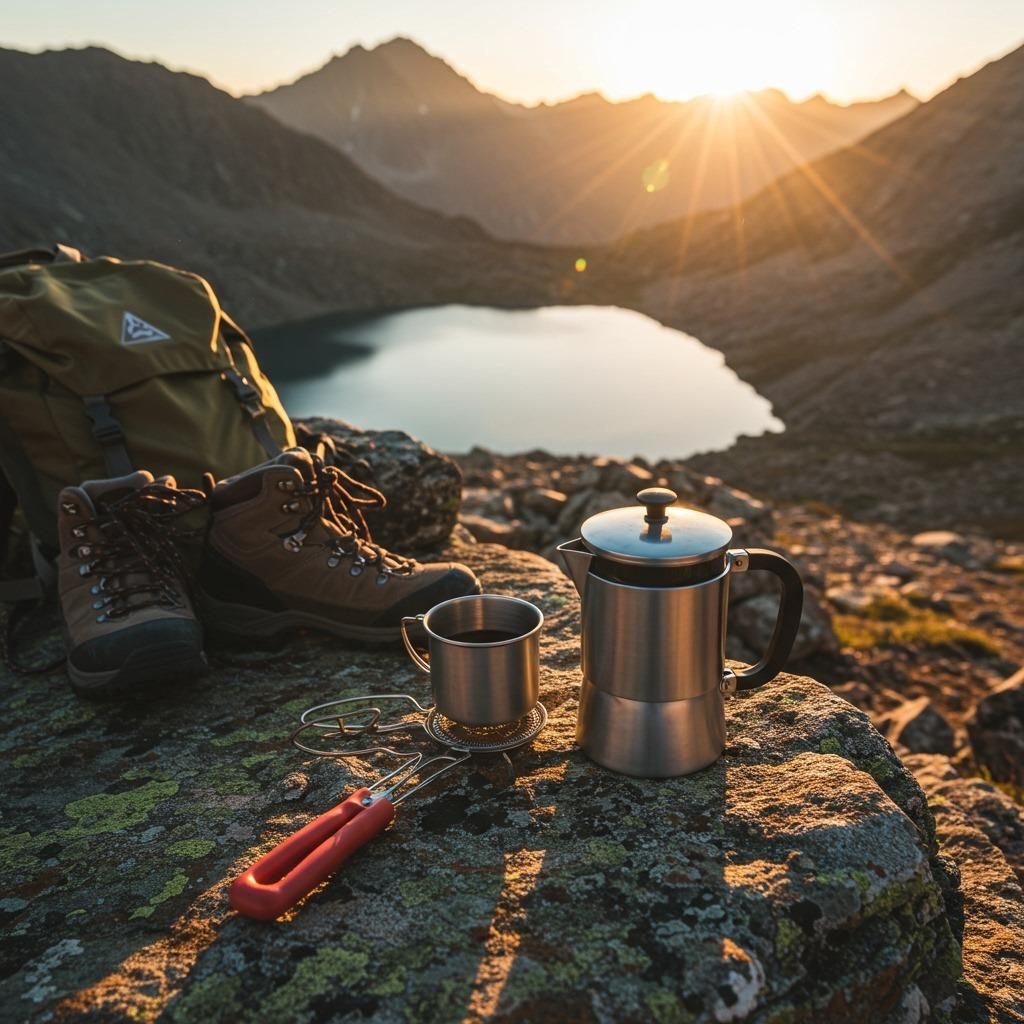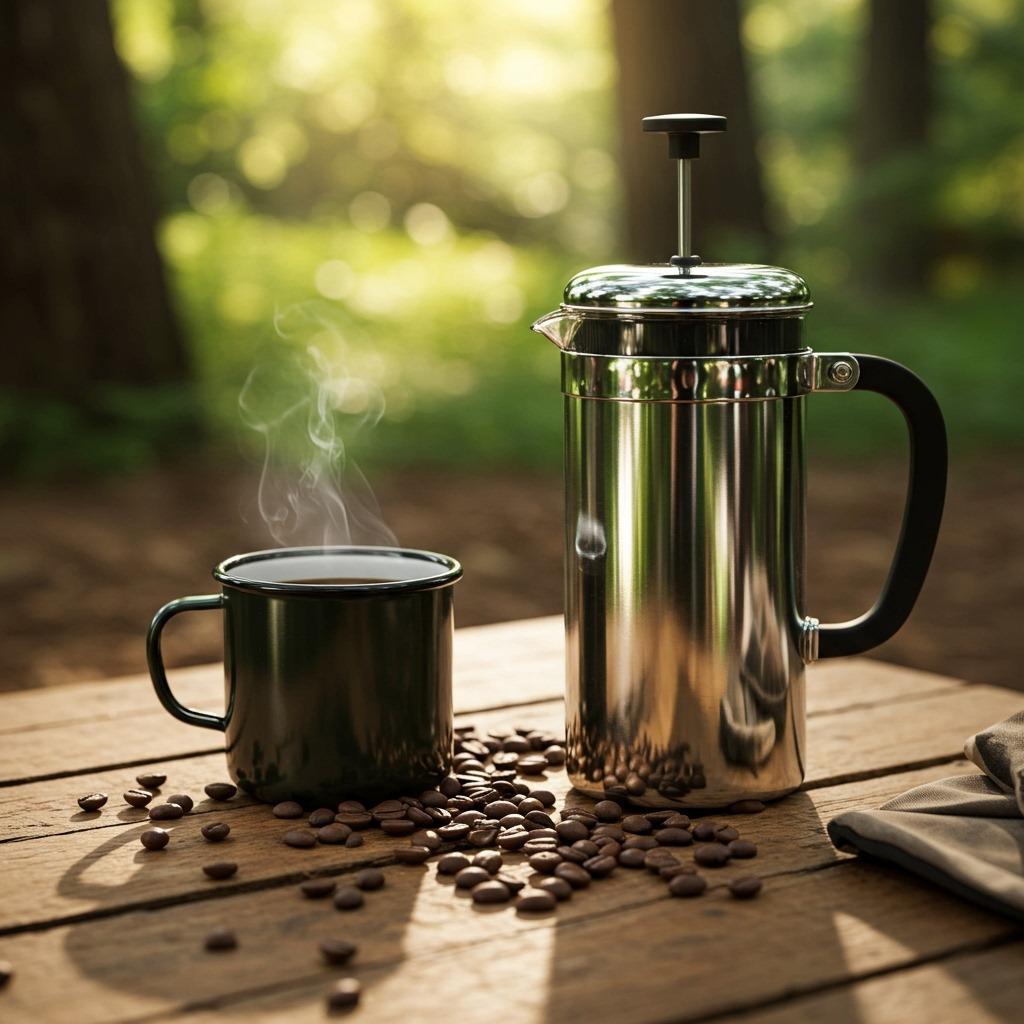Three years ago, I was shivering in my tent at 7,000 feet in the Sierra Nevada, fumbling with instant coffee packets while my breath fogged up the inside of my shelter. That’s when Jake, my hiking partner, calmly pulled out a battered stainless steel French press and started what looked like a coffee ritual. Within minutes, the smell of real coffee filled our campsite, and I knew I’d been doing backcountry mornings all wrong.
French press coffee is an immersion brewing method where coarse coffee grounds steep in hot water for 4-5 minutes, then are separated by pressing down a metal mesh plunger. This technique produces rich, full-bodied coffee with natural oils and sediment that create a hearty, satisfying brew—perfect for outdoor adventures when you need substantial morning fuel. Unlike drip coffee or espresso, the French press delivers bold flavors and maximum caffeine extraction while requiring minimal equipment and technique.
If you’re already exploring ways to fuel your outdoor adventures properly, our comprehensive guide to how to make cowboy coffee offers another classic camping brewing method that pairs well with French press techniques.

What You Need for Perfect French Press Coffee
Essential Equipment:
- French press (glass, stainless steel, or plastic)
- Coarse-ground coffee or whole beans with a grinder.
- Hot water (195-205°F)
- Timer
- Stirring spoon
- Scale (optional but recommended)
Coffee-to-Water Ratio:
The standard ratio is 1:15 to 1:17 (1 gram coffee per 15-17 grams water), which translates to roughly 2 tablespoons ground coffee per 6 ounces of water. For a typical 34-ounce French press, use about 1/2 cup (50-60g) coarse grounds with 3-4 cups of water.
Grind Size Matters:
Coarse grounds—resembling breadcrumbs or sea salt—work best for French press brewing. Fine grounds pass through the mesh filter and create muddy, over-extracted coffee. If buying pre-ground coffee, look for “coarse” or “French press” grind settings.
Water Temperature:
Ideal water temperature ranges from 195-205°F. Bring water to a rolling boil, then let it cool for 30-45 seconds. Water that’s too hot extracts bitter compounds, while cooler water under-extracts and tastes weak.
French Press Types:
- Glass: Shows brewing process, retains heat well, fragile for outdoor use
- Stainless steel: Durable, insulated, perfect for camping, harder to monitor brewing
- Plastic: Lightweight for backpacking, less heat retention, may absorb odors over time
Step-by-Step French Press Brewing Guide
Step 1: Preheat Your French Press
Pour hot water into the empty French press, swirl for 10 seconds, then discard. This warms the vessel and helps maintain brewing temperature throughout the process.
Step 2: Measure and Add Coffee
Add coarse coffee grounds to the empty, warmed French press. Use approximately 2 tablespoons per 6 ounces of water, or weigh out your preferred ratio if using a scale.
Step 3: Start with the Bloom
Pour just enough hot water to saturate all grounds (about double the coffee weight). Stir gently to ensure even saturation. This “bloom” releases trapped CO2 gases and prepares the grounds for optimal extraction. Wait 30 seconds.
Step 4: Add Remaining Water
Pour the rest of your hot water over the bloomed grounds, filling to the desired level. Don’t fill completely to the top—leave room for the plunger mechanism.
Step 5: Steep for 4 Minutes
Place the lid on your French press with the plunger pulled all the way up. Set your timer for 4 minutes. Longer steeping extracts more flavor but can become bitter; shorter steeping may taste weak.
Step 6: Stir and Settle
After 4 minutes, remove the lid and gently stir the coffee crust that formed on top. This helps the grounds settle to the bottom. Wait an additional 30-60 seconds for particles to sink.
Step 7: Press Slowly
Replace the lid and slowly press the plunger down for over 15-30 seconds. Apply steady, gentle pressure—pressing too fast forces fine particles through the filter and creates gritty coffee.
Step 8: Serve Immediately
Pour coffee into cups right away. Leaving brewed coffee sitting on the grounds continues extraction and creates bitter flavors. If not serving all at once, transfer to a thermal carafe.

Troubleshooting Common French Press Problems
Muddy, Gritty Coffee:
- Grind too fine—switch to a coarser setting
- Pressing the plunger too fast—slow down to 15-30 seconds
- Old or damaged filter—replace mesh screen
- Cheap pre-ground coffee with inconsistent particle size
Weak, Sour Coffee:
- Not enough coffee grounds—increase ratio to 1:15 or stronger
- Water too cool—ensure 195-205°F temperature
- Steeping time too short—extend to 4-5 minutes
- Grind too coarse—try medium-coarse instead
Bitter, Over-Extracted Coffee:
- Steeping too long—stick to a 4-minute maximum
- Water too hot—let boiled water cool 30-45 seconds
- Grinding too fine causes over-extraction
- Dark roast requiring gentler treatment
Inconsistent Results:
- Invest in a burr grinder for uniform particle size
- Use a timer for consistent steeping periods
- Measure coffee and water ratios precisely
- Maintain equipment cleanliness between uses
Temperature Loss During Brewing:
- Preheat the French press thoroughly
- Use insulated/stainless steel models for outdoor use
- Cover with a towel during steeping to retain heat
- Start with slightly hotter water (205°F) to compensate for cooling
For outdoor troubleshooting and general camping skills, our camping hacks guide includes additional problem-solving techniques that complement coffee brewing challenges.
Advanced French Press Techniques
The James Hoffmann Method:
This popular technique emphasizes gentle handling and patience:
- Add all water at once (no bloom phase)
- Stir after 4 minutes to break the crust
- Wait 5-8 additional minutes for the grounds to settle completely
- Press the plunger down gently just below the surface level
- Pour slowly to minimize disturbance
Cold Brew French Press:
Use room temperature water with a 1:8 coffee ratio. Steep 12-24 hours in refrigerator, then press and serve over ice. Creates smooth, low-acid concentrate perfect for hot weather camping.
Double Filtering:
For ultra-clean results, pour pressed coffee through a paper filter or fine mesh strainer. Removes remaining sediment while preserving oils and body.
Multiple Extraction:
After the first press, add more hot water to the used grounds for a lighter “second cup.” Steeps faster (2-3 minutes) and provides milder coffee perfect for afternoon sipping.
Spiced French Press:
Add whole spices (cardamom pods, cinnamon sticks, star anise) directly to grounds before brewing. Creates warming, complex flavors excellent for cold-weather camping.
Protein Enhancement:
Add collagen powder or protein supplement during the final 30 seconds of steeping for a post-workout recovery coffee that provides sustained energy for outdoor activities.
According to the Specialty Coffee Association, proper brewing technique and equipment maintenance are more important than expensive gear for achieving consistent, high-quality results.
Outdoor-Specific French Press Considerations
Altitude Adjustments:
High altitude affects extraction due to lower atmospheric pressure and boiling point changes:
- Water boils at lower temperatures—use immediately after boiling
- Extend steeping time by 30-60 seconds for proper extraction
- Grind slightly finer to compensate for reduced pressure
- Expect more intense flavors due to the concentrated atmosphere
Weather Considerations:
- Cold weather: Preheat French press longer, use insulated models, brew slightly stronger to account for rapid cooling
- Hot weather: Reduce steeping time slightly, consider cold brew methods, store equipment in shade
- High humidity: Store coffee beans in sealed, moisture-proof containers
- Wind: Shield the brewing area to prevent heat loss and debris contamination
Pack Weight Optimization:
- Choose lightweight stainless steel or BPA-free plastic models
- Pre-grind coffee at home for weight savings (sacrifice some freshness)
- Multi-use items—some French presses double as cooking pots
- Consider collapsible or nesting designs for space efficiency
Water Source Management:
- Always filter or treat natural water sources before brewing
- Carry extra water specifically for coffee—avoid using cooking/cleaning water
- Hard water from streams may require longer extraction times
- Boil questionable water sources for safety, then cool to the proper temperature

Choosing the Right French Press for Your Adventures
Car Camping Options:
Large glass or stainless steel models (32-48 oz) work well when weight isn’t critical. Look for double-wall insulation and durable construction. Popular brands include Bodum, Espro, and Stanley.
Backpacking Models:
Prioritize weight and durability. Titanium or lightweight stainless steel options under 12 oz work best. Consider GSI Outdoors, Sea to Summit, or custom ultralight makers.
Multi-Day Expedition Gear:
Bombproof construction matters more than weight. Stainless steel military-style presses handle abuse and maintain functionality in extreme conditions.
Budget Considerations:
- Under $25: Basic glass models for occasional use
- $25-75: Quality stainless steel with good filters
- $75-150: Premium insulated models with advanced filtration
- $150+: Titanium ultralight or luxury designs
Filter Quality Assessment:
Multiple screen layers prevent grounds from passing through. Look for fine mesh (200+ micron) with sturdy construction. Replacement filters should be readily available.
Capacity Planning:
- Individual use: 12-20 oz models
- Two people: 24-32 oz capacity
- Group camping: 48+ oz for efficiency
- Consider brewing multiple smaller batches vs. one large batch for optimal temperature retention
For comprehensive outdoor gear selection principles, our guide to the best camping clothes for comfort and durability applies similar evaluation criteria to coffee equipment choices.
Maintenance and Cleaning
Daily Cleaning Routine:
- Disassemble all removable parts immediately after use
- Rinse thoroughly with hot water to remove oils
- Use mild soap for deep cleaning, avoiding harsh detergents
- Scrub the mesh filter gently with a soft brush to prevent damage
- Air dry completely before reassembling
Deep Cleaning Weekly:
- Soak parts in hot water with a baking soda solution
- Use an old toothbrush to clean the mesh filter thoroughly
- Remove mineral deposits with a white vinegar soak
- Replace filters annually or when damaged
Outdoor Cleaning Challenges:
- Limited water supplies require efficient cleaning methods
- Pack lightweight camp soap for proper degreasing
- Use heated water for effective oil removal
- Store cleaned parts in protective cases to prevent damage
Storage Considerations:
- Store disassembled to prevent moisture from being trapped
- Protect glass models with padded cases
- Check rubber seals periodically for wear
- Keep replacement parts accessible for field repairs
Coffee Selection for French Press Brewing
Roast Level Preferences:
- Light roasts: Bright, acidic flavors shine through full immersion
- Medium roasts: Balanced sweetness and acidity, most versatile
- Dark roasts: Bold, smoky flavors complement full-body extraction
- Very dark roasts: May become overpowering—reduce steeping time
Origin Characteristics:
Different coffee regions produce distinct flavor profiles that work exceptionally well with French press brewing:
- Central American: Clean, bright acidity with chocolate notes
- South American: Nutty, caramel sweetness with full body
- African: Floral, fruity complexity enhanced by immersion brewing
- Indonesian: Earthy, herbal flavors with heavy body
Bean Freshness Importance:
Use beans roasted within 2-4 weeks for optimal flavor. French press brewing extracts oils and compounds that dissipate quickly in stale coffee. Buy whole beans and grind immediately before brewing when possible.
Grind Timing:
Pre-ground coffee stales within days, but whole beans maintain quality for weeks. For extended outdoor trips, consider:
- Vacuum-sealed pre-ground portions for convenience
- Hand grinder for fresh grinding (adds weight but improves flavor)
- Cold brew concentrate that travels well and doesn’t require grinding
For those planning longer outdoor adventures, our detailed camping for beginners guide covers essential skills that complement advanced coffee techniques.

Health Benefits and Nutritional Profile
Antioxidant Content:
French press coffee retains more antioxidants than filtered methods because the metal mesh allows beneficial oils and compounds to remain in the final brew. These compounds may support cardiovascular health and reduce inflammation.
Caffeine Levels:
French press typically contains 80-120mg caffeine per 8-oz cup—similar to drip coffee but with more consistent extraction. The full immersion method ensures complete saturation and optimal caffeine extraction.
Cholesterol Considerations:
Unfiltered coffee contains cafestol and kahweol—compounds that may raise cholesterol levels in sensitive individuals. Paper filters remove these oils, but the French press retains them. Monitor cholesterol levels if consuming large quantities daily.
Digestive Benefits:
The lower acidity of French press coffee (compared to drip methods) may be gentler on sensitive stomachs. The full-bodied nature also pairs well with food, reducing potential digestive irritation.
Performance Enhancement:
For outdoor enthusiasts, French press coffee provides:
- Sustained energy release from natural oils
- Enhanced focus for technical activities like climbing or navigation
- Improved endurance during prolonged physical exertion
- Social benefits of shared brewing rituals in group settings
Nutritional Profile (8 oz black French press coffee):
- Calories: 2-5
- Caffeine: 95-120mg
- Antioxidants: High levels (higher than filtered coffee)
- Minerals: Potassium, magnesium, niacin
- Oils: Natural coffee oils retained (unlike paper-filtered methods)
Regional Variations and Cultural Significance
French Origins:
Despite its name, the French press was actually invented in Italy in 1929, though earlier versions existed in France. The design gained popularity throughout Europe before reaching North America.
Scandinavian Coffee Culture:
Nordic countries embrace French press brewing for its ability to highlight light roast complexity. Their coffee culture emphasizes quality beans and precise brewing techniques.
Outdoor Traditions:
The French press gained popularity among outdoor enthusiasts due to its durability and ability to brew quality coffee without electricity. Many wilderness guides consider it essential equipment.
Modern Specialty Coffee:
Third-wave coffee shops often feature French press service for single-origin coffees, allowing customers to experience unfiltered flavor profiles that showcase specific terroir characteristics.
Global Adaptations:
- Australia: “Plunger coffee” is a standard cafe offering
- Canada: Essential camping equipment across provinces
- Military use: Rugged construction suits field conditions worldwide
Understanding these cultural contexts enriches the French press experience and connects modern outdoor enthusiasts to broader coffee traditions.
Sustainability and Environmental Impact
Equipment Longevity:
Quality French presses last for decades with proper care, making them more environmentally friendly than single-use brewing systems. Stainless steel models offer the best durability-to-impact ratio.
Filter Waste:
Unlike paper filter methods, the French press produces minimal ongoing waste. Metal filters never need replacement (unless damaged), significantly reducing environmental footprint over time.
Bean Sourcing:
Choose certified organic, Fair Trade, or Direct Trade coffee to support sustainable farming practices. French press brewing showcases bean quality, making ethical sourcing investments worthwhile.
Water Conservation:
French press requires precise water measurements, reducing waste compared to automatic machines that may overheat unnecessary quantities. Outdoor use encourages mindful water consumption.
Packaging Considerations:
Buy whole bean coffee in bulk to minimize packaging waste. Reusable containers reduce ongoing environmental impact during extended outdoor adventures.
Leave No Trace Principles:
- Pack out all coffee grounds (excellent compost material at home)
- Use biodegradable soap for cleaning in wilderness settings
- Dispose of wash water properly (strain grounds, scatter gray water)
- Choose durable equipment requiring fewer replacements
According to Leave No Trace Center guidelines, responsible coffee brewing practices protect wilderness areas while allowing continued access for future generations. The organization emphasizes that small changes in outdoor habits collectively make significant environmental impacts.
Frequently Asked Questions
How long should I steep French press coffee?
Steep for exactly 4 minutes for balanced extraction. Longer steeping (5-6 minutes) creates stronger, potentially bitter coffee, while shorter times (2-3 minutes) may taste weak and sour. Advanced techniques like the Hoffmann method use longer total times but different approaches to settling and pressing.
What grind size works best for a French press?
Use coarse grounds resembling breadcrumbs or coarse sea salt. Fine grinds pass through the metal filter, creating muddy, over-extracted coffee. If your coffee tastes weak with coarse grinds, increase the coffee-to-water ratio rather than using finer particles.
Can I use regular ground coffee from the store?
Yes, but buy coffee specifically labeled “coarse” or “French press grind.” Regular ground coffee is usually medium-fine, designed for drip machines, and will create gritty, bitter results in a French press. Whole beans ground fresh always produce better flavor.
Why does my French press coffee taste bitter?
Bitterness usually indicates over-extraction from water that’s too hot (above 205°F), steeping too long (over 5 minutes), or using grounds that are too fine. Try using slightly cooler water, reducing steep time to 4 minutes, or switching to coarser grounds.
How do I prevent grounds from getting in my cup?
Press the plunger slowly and steadily for 15-30 seconds. Fast pressing forces particles through the filter. After pressing, wait 30 seconds before pouring to let the remaining particles settle. Some grounds are normal—French press coffee naturally contains more sediment than filtered methods.
Can I make cold brew in a French press?
Absolutely! Use a 1:8 coffee-to-water ratio with room temperature water. Steep 12-24 hours in the refrigerator, then press and serve over ice. Cold brew French press creates smooth, concentrated coffee perfect for hot weather or extended storage.
